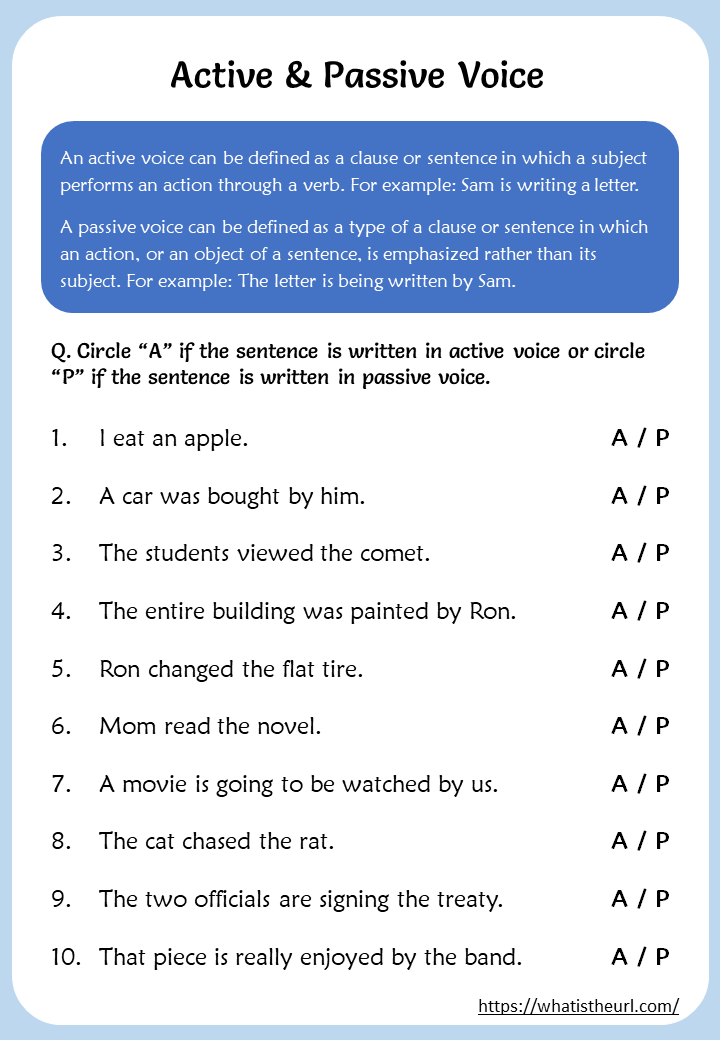Have you ever felt the frustration of struggling with active and passive voice in English grammar? Imagine, for example, you’re writing an essay about your favorite historical figure, and you’re trying to make your sentences flow effortlessly. Suddenly you find yourself questioning whether you should use “The document was written by her” or “She wrote the document.” Choosing between these two options seems like an insurmountable hurdle, right?

Image: www.pdfprof.com
Don’t worry, you’re not alone! This is a common problem that many students and writers face. The difference between the active and passive voice can seem confusing, but it’s essential for clear and impactful writing. The good news? Understanding this distinction is within your reach! This article will demystify active and passive voice. We’ll explore the nuances of each voice, provide practical examples, and even offer a downloadable worksheet with answers to solidify your understanding. Get ready to conquer the complexities of the English language once and for all!
Understanding Active and Passive Voice: A Grammar Deep Dive
The active and passive voice are two ways of constructing sentences in English. They affect how the action of the sentence is presented and who or what is performing that action.
Active Voice: Who’s Doing What?
In the active voice, the subject of the sentence performs the action. This voice directly states the doer of the action and their role in the sentence. Think of it like a straightforward, direct communication.
Example: “The dog chased the ball.”
Here, “The dog” is the subject, and it is performing the action of “chasing.”
Passive Voice: Shifting the Focus
The passive voice, on the other hand, emphasizes the action itself and the object being acted upon. The doer of the action, if mentioned, often appears in a prepositional phrase following the verb. Essentially, the action is highlighted, while the actor might be de-emphasized, or even omitted altogether.
Example: “The ball was chased by the dog.”
Here, the focus is on the action – the ball being chased – and the doer (“the dog”) is less prominent.

Image: www.pinterest.es
The Importance of Understanding Active and Passive Voice
So, why is it so important to know the difference between active and passive voice?
First, choosing the right voice can significantly impact your writing style. Active voice often creates a more direct and engaging tone, while the passive voice can be used to emphasize the action or to avoid placing blame when the doer is unknown or unimportant.
Secondly, understanding the structure of the passive voice helps with parsing complex sentences. Frequently in academic writing or technical documentation, passive voice is used to present information objectively, with the action as the central point.
How to Identify Active and Passive Voice
To spot the active and passive voice, look for the following:
- Active voice: Subject + Verb + Object
- Passive voice: Object + “to be” verb (am, is, are, was, were, etc.) + Past Participle + “by” + subject (may be omitted)
Mastering English Grammar: Active and Passive Voice Worksheets
Now that you understand the basics, it’s time to test your knowledge! Practice makes perfect, and there’s no better way to solidify your understanding than with worksheets. Below we’ve provided a list of resources that offer active and passive voice worksheets with answers:
Active and Passive Voice Worksheets: Free Online Resources
Here are some excellent sources for free, printable worksheets to practice identifying and converting active and passive voice sentences:
- English for Everyone: Active and Passive Voice Worksheet
- Grammar Book: Active and Passive Voice Exercise
- ESL Buzz: Active and Passive Voice Exercise
- Perfect English Grammar: Active and Passive Voice Exercise
Tips for Using Worksheets
When working through these active and passive voice worksheets, keep the following tips in mind:
- Take your time: Don’t rush through the exercises. Focus on understanding the underlying concepts and applying them to each sentence.
- Refer to the answers: Use the provided answers to check your work. This will help you identify your strengths and areas for improvement.
- Practice regularly: The more you practice, the more confident you’ll become in your ability to distinguish between active and passive voice.
- Read widely: Pay attention to the way active and passive voice are used in books, articles, and other written works. This will help you to develop an intuitive understanding of the nuances of each voice.
FAQ: Active and Passive Voice
Q: When should I use the passive voice?
The passive voice is often used when:
- The doer of the action is unknown or unimportant.
- You want to emphasize the action or the object that is acted upon.
- You want to avoid placing blame.
- You desire a formal or objective tone.
Q: Why is the active voice generally preferred?
The active voice is often preferred because it creates a clearer, more direct, and engaging tone. The active voice makes your writing dynamic and prevents sentences from becoming wordy or vague.
Q: How can I avoid overuse of the passive voice?
To prevent overuse of the passive voice, ask yourself: “Who or what is performing the action?” If you can identify the subject, it’s often more effective to use the active voice.
Active And Passive Voice Worksheet With Answers Pdf
Conclusion
By mastering active and passive voice, you’ll be better equipped to write clear, impactful, and engaging sentences. The resources we’ve provided, including active and passive voice worksheets with answers, can help you improve your grammar skills and enhance your overall writing abilities.
Are you excited to tackle active and passive voice with newfound confidence? Let us know in the comments below!






